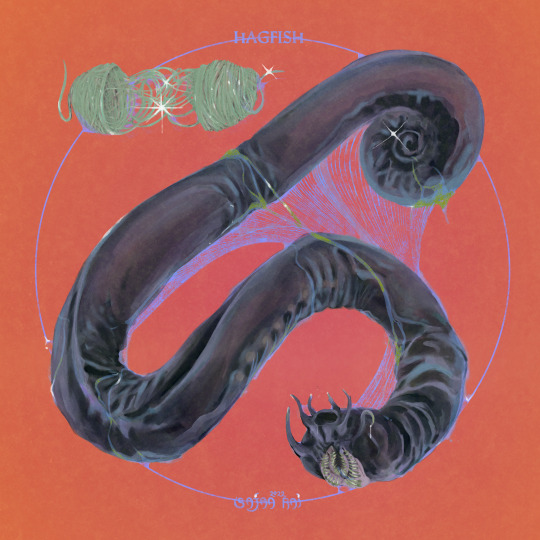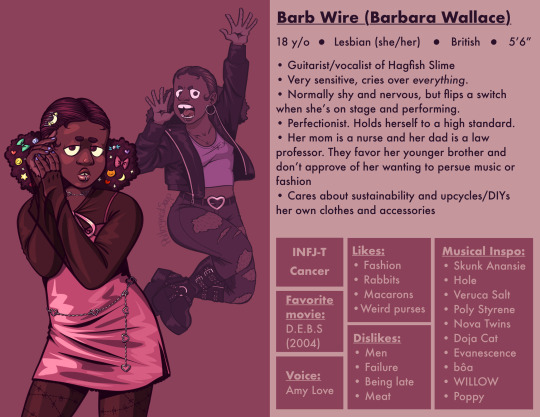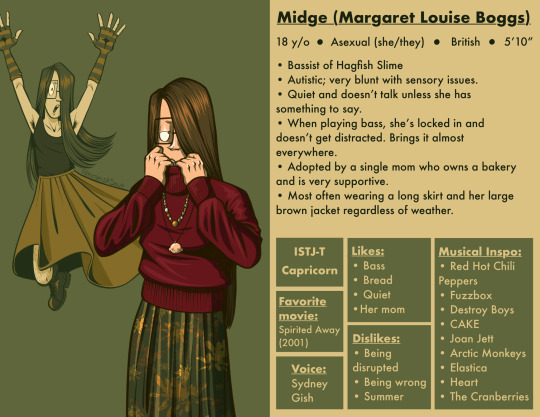#hagfish slime
Explore tagged Tumblr posts
Text

Valenslimes
22 notes
·
View notes
Text

Comic page practice from a while ago!! :))
#fantasy#artists on tumblr#art#fantasy art#concept art#original comic#original characters#comic#comic concept#monster#hagfish slime#hagfish#barnacle#horrible beast#beast#eugh#landscape#another world
10 notes
·
View notes
Text
Oh these fuckers are so so weird and gross and slimy (affectionate). The slime! It’s fucking cool.
this article is so crazy like whoa
#nature and animals#animals#science#biology#sea life#marine biology#hagfish#hagfish slime#underwater weirdos
9K notes
·
View notes
Note
Hagfish Slime roots too ;P
Roots: clothing inspiration
* Barb is the most versatile in terms of what she wears and takes inspiration from a lot of different things because she likes to DIY her pieces and accessories. She’s visually inspired by Amy Love of the Nova Twins, but I also pull from Skin (lead singer of Skunk Anansie), with a little bit of Harajuku street fashion.




She is the lead singer and dresses the part, but she is not overly glamorous— if she’s wearing makeup, it’s a bold eyeshadow or a funky lipstick. Her style is more feminine than Midge and Barb’s, but not completely impractical. She has the most variety in her outfits, but often with the same sets of pieces styled differently. Her favorite accessories are earrings and weird purses.
* Midge tends to choose comfort over style and most of her outfits consist of a long skirt, a tee shirt, and her oversized jacket. If she is accessorizing or dressing up, her style is inspired by Janis Joplin and Patti Smith. Her preferred silhouette is loose and formless and she prefers having her legs covered.



* Kenny has no specific style inspo, she’s just dressed like that one boy in your class who wore a tee shirt with a monster truck and his hair spiked up for every single picture day. She prefers having her arms and legs free. This is her style:



* Generally my main inspo is 90s riot girl but that is extremely loose and their style is not necessarily meant to look 90’s.
* The 3 of their styles vary between feminine and masculine but all 3 of them don’t shave because body hair is not an inherently masculine trait, it’s just neutral because it comes with your endocrine system and I think we should see it more both in gnc characters and feminine characters.
* I just think it’s important that if your fictional band is meant to be part of an inherently political genre like riot girl, the characters should have distinct styles and personalities and also that it’s kinda fucking stupid to put your fictional riot girl band in schoolgirl inspired uniforms and miniskirts and heels lol
1 note
·
View note
Text

my pacific hagfish piece for @seaunseenzine !! all proceeds go to helping marine conservation -- go grab a copy! 🌊🌊🌊
2K notes
·
View notes
Text

happy hagfish day for all those that celebrate. I encourage you to learn about one of my favourite animals
1K notes
·
View notes
Text
Wet Beast Wednesday: hagfish
After taking last week off for mental exhaustion I have returned! And what better way to mark my return than with a shitload (or perhaps a highway load) of slime? Today I'm returning to the agnathan trenches to dredge up one of two living groups of jawless fish. I covered lampreys before, so now it's hagfish time. These ooey gooey critters are both fascinating and kinda gross. Now get ready, because it's time for slime.

(Image: a hagfish in profile. It is a long, brown, eel-like animal with a fin encircling the tail and a small head with no visible eyes or mouth. End ID)
Hagfish, also known as slime eels, are approximately 76 members of the class Myxini. In addition to the living species, hagfish have been preserved in the fossil record, letting us track their evolution through history. Hagfish are one of two living groups of agnathans, commonly known as jawless fish, with the other being the lampreys. As the name suggests, jawless fish are vertebrates without hinged jaws. Way back when bones were the cool new thing in town, agnathans represented the entirety of the vertebrates and were extremely diverse, but the evolution of jawed fish resulted in them getting largely outcompeted, leading to all lineages but the hagfish and lampreys going extinct. Genetic studies indicate that hagfish and lampreys are more closely related to each other than either group is to any other vertebrate. Because they are the only jawless fish left, hagfish and lampreys are of interest to scientists studying the evolution of vertebrates.

(Image: a hagfish coiled up, under orange light. The head is visible, featuring small sensory barbels and a large hole that resembles a mouth but is actually the nostril. End ID)
Hagfish are eel-shaped animals that range in length from a few centimeters to over a meter in the largest species, Eptatretus goliath. They have no scales, flattened tails that bear the only fin, and simple, eyeless heads. The heads bear sensory barbels, a single nostril, and the mouth. The mouth has two pairs of rasping plates that normally sit within the mouth, but can be everted to face outwards. The plates can grab food and pull it into the mouth to be swallowed. Hagfish do not have true eyes, but they do have eyespots that can sense light and dark. Interestingly, their fossil ancestors did appear to have fully-developed eyes that reduced in complexity until the present state. Likewise, ancestral hagfish had a true vertebral column made of cartilage, but modern hagfish only have remnants of their ancestor's vertebrae. Hagfish skin is very loosely connected to the internal body, only attached along the spine and slime glands. This makes the skin very flexible and harder for predators to grab. A third of the blood is contained between the skin and body and is pumped around with the heart as well as a few additional pumps that act as auxiliary hearts. Hagfish have some of the lowest blood pressure of any vertebrate and the highest blood volume to body mass ration of any chordate. Hagfish are also the only vertebrates that do not osmoregulate, meaning they cannot regulate the amount of salt in their bodies. Changes in salinity, especially moving to a lower salinity environment, are very dangerous to hagfish. Hagfish skeletons barely qualify, consisting of only a skull, notochord, and fin rays, all made of cartilage. The gills are internal. Water enters through the mouth and is forced over 5-16 internal gill pouches, then ejected through pores in the side of the body.

(Image: a closeup of a hagfish head with the rasping plates everted. The plates are mounted on pink tissue around the pharynx. there are two plates on either side of the pharyx which look like rows of small, sharp teeth. End ID)
That's all well and good, but you're here because of the slime. The hagfish's main defense is to create lots and lots of slippery slime. The slime helps them slip away from predators. If a fish tries to eat a hagfish, the slime can clog up its gills, forcing the fish to either release the hagfish or suffocate. A common factoid is that a single hagfish can turn a 5-gallon bucket of water into slime in seconds. To produce the slime, the hagfish releases threads made of special proteins into the water from glands on its skin. These proteins react with seawater to create a matrix of trapped water held together by filaments similar to keratin. The slime matrix can expand 10,000 times its original size in 0.4 seconds of exposure to seawater. The slime is quite durable and resistant to breaking and dissolving in water. After sliming, hagfish have been seen wrapping their bodies into an overhand knot and running themselves through the loop to scrape the slime off of themselves. Its possible that the slime also impairs the hagfish's ability to use it's gills and it needs to do the know to get the slime off and breathe again.

(Image: a person reaching into a holding tank full of hagfish and pulling out an armload of thick, viscous, white slime. End ID)
youtube
(Video: a hagfish in the wild demonstrating its knotting behavior. This one is going in the opposite direction usually seen: tail-to-head instead of head-to-tail. End ID)
Hagfish are found in most of the oceans, with range varying based on species. They are benthic animals that rarely swim far above the seafloor. Some species dig burrows to shelter in while others will shelter under rocks and other structures to avoid predators. While lying on the sediment, some hagfish species will coil up while others will lie straight. Hagfish are carnivorous and feed with a combination of hunting and scavenging. A large portion of the hagfish diet consists of polychaete worms and other known prey species include small crustaceans and echinoderms. Some species have been known to hunt burrowing fish, possibly by clogging up the burrows with slime to suffocate the prey. If you've seen a documentary about deep-sea fish you probably know about hagfish scavenging. Using their large nostril and sensitive sense of smell, hagfish can sense carcasses from long distances and are often some of the first scavengers to arrive at a new body. They use their rasping plates to pull bits of meat off of the carcass. A similar behavior to the slime-cleaning knots is seen when scavenging, but in reverse, going from tail to head instead of the other way around. This grants the hagfish additional mechanical advantage, allowing it to rip off larger chunks of food. Hagfish will burrow into larger corpses, possibly to get access to a food source with less competition than the outside of the body. Hagfish act as part of the deep ocean's cleaning crew, consuming corpses before they can decay and release potentially harmful chemicals into the water or act as sources of disease. Unlike any other living chordate, the food a hagfish swallows is encased in a permeable membrane during digestion. Hagfish can also absorbed dissolved nutrients through their skin. Hagfish have a very slow metabolism and ones in captivity have been observed going for up to 7 months between meals.

(Image: several hagfish feeing on the body of a fish. The hagfish have their heads on the fish's body and one hagfish is entering the fish's mouth. End ID)
Hagfish reproduction is still something of an enigma as so many of them live in the deep sea, making it difficult to observe them reproducing. It has been observed that females seem to outnumber males, with the exact ration varying depending on species. In some species, the sex ratio is almost even, while in others, there are 7 females to each male. however, it should be noted that females mature sexually faster than males and it has been suggested that this is responsible for the apparent skewed ratio. Hagfish eggs have tufts at the end that cause them to get stuck to each other like velcro. It has been suggested that eggs are laid in clusters possibly in burrows, beneath rocks, or protected with slime. Some species seem to have a mating season and seasonally migrate. Hagfish have only a single ovary or testicle (the latter of which has been described as unusually small by scientists and bullies in the deep-sea locker room) and they have no specialized reproductive tract. Instead, gametes are released into the main body cavity and must find their way to the anus to leave the body. Hagfish embryology is poorly understood, though it has been reported from studies of Eptatretus stoutii (Pacific hagfish) that the eggs can take up to 11 months to hatch. Hagfish have no larval stage, unlike lampreys and bony fish.

(Image: a group of 9 hagfish eggs in a plastic tub. The eggs are ovoid and dark yellow, with tufts of fibers at each end. End ID)
The conservation status and needs of most hagfish species is hard to discern because of the depths they inhabit. Threats to them include bycatch, as hagfish are often caught during deep-sea dredges. It is alos possible the chemical pollutants may be passed to hagfish through scavenging. There is a commercial fishery for hagfish, which is largest off of the west coast of the Americas. Hagfish are eaten as a delicacy in Korea and less commonly eaten in Japan. Most of the hagfish fishery goes to Korean food markets. Hagfish skin is also values as a durable leather and often marketed as "eel leather" or "yuppie skin". Study of the slime and the highly durable threads that produce it indicates they could be used to create very strong materials, similarly to spider silk. Research is currently being undertaken to find uses for hagfish slime and threads.

Once again, these cards show up in my posts (Image the Weird n' Wild Creatures card for hagfish, featuring an exaggerated drawing on a hagfish. End ID)
#wet beast wednesday#hagfish#agnathan#jawless fish#slime#deep sea fish#fishblr#fish#marine biology#biology#zoology#ecology#informative#educational#image described#cw animal death#Youtube
204 notes
·
View notes
Text
Daily fish fact #770
Hagfish!

Hagfish are most well-known for their slime excreting abilities. Hagfish slime is made possible with mucus and so-called slime threads, which are very long but extremely thin, tightly packed proteins that quickly unravel once excreted out of the body. These threads can expand up to 10 000 times their original size! They react with the mucus and the seawater, forming lots of thick slime. Up to 99.996% of hagfish slime is seawater.
#no one is prepared for hagfish slime#fish#fishblr#fish facts#fishfact#zoology#biology#marine life#marine animals#marine biology#sea animals#sea creatures#sea life#hagfish
191 notes
·
View notes
Text
On the one hand I know most of this kind of research is supposed be foundational, with further research and development building out more practical uses.
On the other hand, it's very funny that researchers invented non-vegan tofu using hagfish slime.
#hagfish#hagfish slime has incredible properties and learning more about how to use it is good!#but also non-vegan tofu makes me go hee hee hoo hoo hee hee
68 notes
·
View notes
Text
It’s time to feast —but do you twist yourself in a knot like a hagfish when it’s time for dindin? As one of just two living species of jawless fish, hagfish are a sight to behold when they scavenge food on the deep seafloor. Share some love for these wriggly friends as they tear off tasty morsels. Bon Appetit!😋
#monterey bay aquarium#we asked if you would love us if we were a worm#but what if we were a hagfish?#aka slime eel#twisting and turning and screaming and scavenging
1K notes
·
View notes
Text

it is not swunday but I DID draw a swindle ft Vortex's really bad prank ft REALLY rough draft design for miss 'Tex
#art#maccadam#swindle#vortex#vortex voice oh boy what should I do with these several barrels of hagfish#also ft me misremembering that one atlantic article#correct quote is no one is prepared for hagfish slime
66 notes
·
View notes
Text



Hagfish Slime refs for art fight
Keep enabling me— how about a tip?
63 notes
·
View notes
Text
this is playable now! silly interactive fiction twine game ft. highway robbers and fairies. on itch here / spring thing webpage here 🌿
#do i know what i'm doing? no. will that stop me? no#twine#interactive fiction#games by mo#if you find bugs for the love of god tell me. i am haunted and bedevilled by the prospect of things breaking#gay belligerence#this is mostly a 'click link to progress shenanigans' game. with like two puzzles in it#it's lived in my unfinished projects zone for about a billion years. time to expel it. in a jet of slime hagfish-style
93 notes
·
View notes
Text


I was informed Hagfish Day was actually last week.. umm it takes a while to swim from the abyssal zone ok?? hagfish love should be year-round anyway!
ink on paper
51 notes
·
View notes
Text
happy heckin #hagfishday

get some slime di$counts
8 notes
·
View notes
Text
it would be fun to make a hagfish in slime design and other sentences said by normal people
#IT WOULD. IT WOULD THOUGH. i could do a partially clear gradient for the slime cloud.... don't u want a little hagfish on ur laptop.#brainstorming ideas for things people might actually want to fucking buy. possibly might have to shelve that one for now.#it would be so awesome though....#txt
9 notes
·
View notes